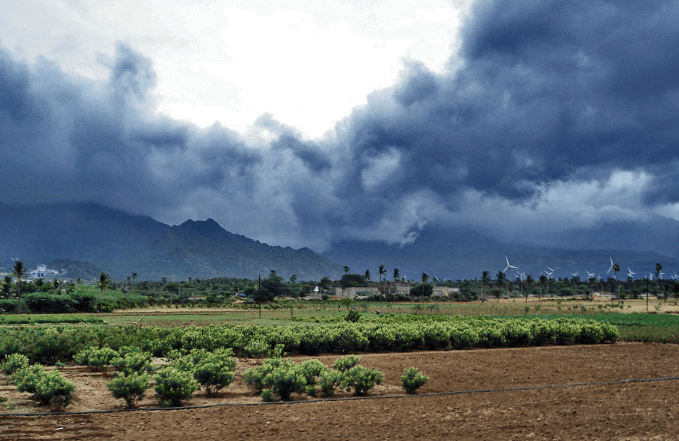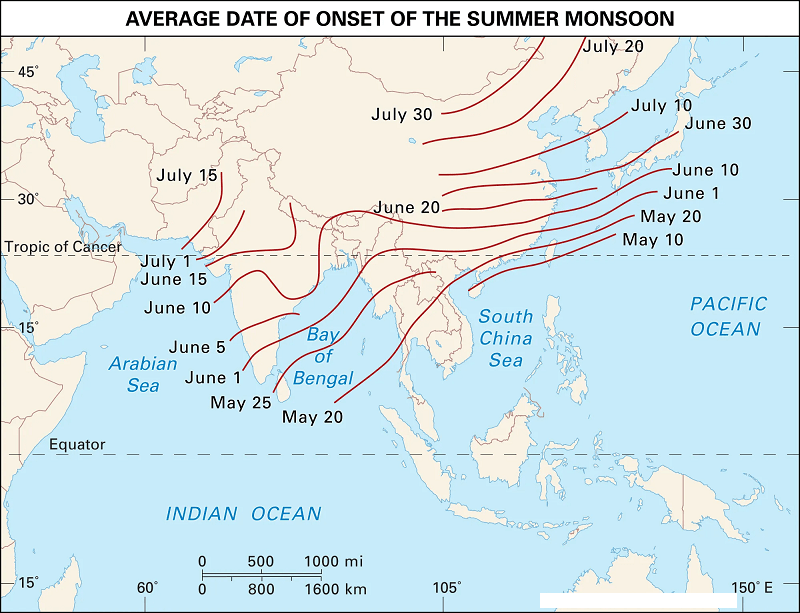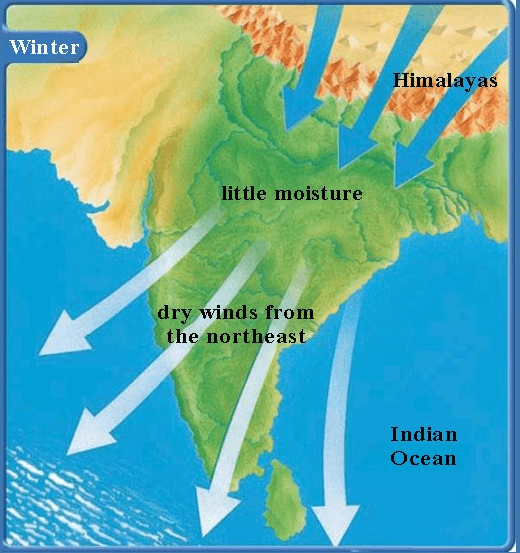Monsoon Definition
Monsoon
A monsoon is a seasonal swing in a region's strongest or most prevalent winds. Due to monsoons, most regions experience wet and dry seasons.

A monsoon is a seasonal swing in an area's strongest or most frequent winds. Many of the regions experience rainy and dry seasons due to monsoons. The Indian Ocean is most likely connected to monsoons.
Monsoons frequently swing between cool and warm regions. The winter and summer monsoons influence most of India and Southeast Asia's climate.
The Summer Monsoon

- During the summer monsoon, there is frequently a lot of rain.
- It often occurs between April and September.
- When the winter months conclude, warm, humid air from the southwest Indian Ocean moves into Bangladesh, Sri Lanka, India, and Myanmar.
- The summer monsoon produces heavy rains and a humid atmosphere in these places.
- The summer monsoon is essential to India and Southeast Asia. Agriculture, for example, is dependent on yearly rainfall. Many of these nations' lake, river, and snowmelt areas need more irrigation infrastructure. Aquifers, or underground water reserves, are small. The summer monsoon throughout the year refills wells and aquifers. Two crops that are dependent on the summer monsoon are rice and tea. The monsoon rains are also essential for dairy farms that contribute to India being the world's largest milk production to maintain healthy and well-fed cows.
- The summer monsoon is also important for business in Southeast Asia and India. With water gathered during the monsoon season, the area's hydroelectric power units produce much of the region's electricity. Hospitals, schools, and companies that support these regions' economies are run by electricity.
- When the summer monsoon arrives late or poorly, the local economy suffers. Fewer individuals can raise food, and big agribusinesses cannot sell products. Governments must import food. Electricity prices rise, often restricting development to big firms and well-off people. India's actual finance minister has been dubbed the summer monsoon.
- Strong summer monsoons might cause a lot of harm. The streets in large cities like Mumbai, India, regularly flood with about half a meter (1.5 feet) of water during the summer. But flooding might hurt the region if the summer monsoon exceeds what is expected. Entire neighborhoods can submerge in places like Mumbai. Mudslides may bury villages and ruin crops in rural regions.
- A powerful monsoon destroyed western India in 2005. Gujarat was the first place the summer monsoon made landfall after coming from the southwest. Over a hundred individuals were killed. Then, the state of Maharashtra saw monsoon rainfall. More than 1,000 people died in Maharashtra as a result of flooding. On July 26, 2005, there was nearly a meter (39.1 inches) of rain in Mumbai, Maharashtra.
Winter Monsoon

- The Indian Ocean's winter monsoons, which continue from October to April, are less well-known than their similarly rainy summer counterparts. Northeastern winds are responsible for the dry winter monsoon. The origin of these winds is in the atmosphere above Mongolia and northwest China.
- Since the Himalayan Mountains prevent much of the wind and moisture from the monsoons from reaching the shore, Southeast Asia's winter monsoons are less powerful than its summer ones. A large portion of the cool air is also prevented from reaching locations like southern India and Sri Lanka by the Himalayas, keeping those regions warm all year. Droughts and winter monsoons can occur together occasionally.
- However, not all winter monsoons are dry. The rainy season on Southeast Asia's eastern Pacific coast occurs in the winter, as opposed to the summer on its western shore. Humid air from the South China Sea is transported to countries like Indonesia and Malaysia during the winter monsoon.
Various Monsoons
- The Asian-Australian monsoon, which expands from northern Australia to Russia's Pacific coast, is partially bounded by the Indian Ocean. After that, this enormous monsoon wind system extends into the Indian Ocean. Everything ultimately comes to an end on the African continent's Indian shore.
- There are monsoon winds elsewhere in the world as well. In North America, the yearly monsoon frequently hits during the peak of the summer. Compared to air from the northwest-flowing Gulf of Mexico, air from the Gulf of California is warmer and more humid. Over Mexico's Sierra Madre Occidental mountains, these two winds combine. Before moving farther north to Arizona, New Mexico, and Texas, the monsoon sends moisture to the mountain ecosystem.
- Firefighters may be able to use a natural resource from the North American monsoon. Arizona's summertime highs often exceed 100 degrees Fahrenheit, making putting out flames challenging. Most of the region's desert ecosystems get their main water supply from the North American monsoon. But, for some people who aren't accustomed to coping with severe rain, it may also be perplexing and disturb daily life.
What Brings on the Monsoon?
Ocean and land surfaces get heat from the sun throughout the summer, but land temperatures rise more rapidly because the land has a smaller heat capacity. The air above the planet expands as it heats, creating a low-pressure region. The air above the water is still under higher pressure since the sea is warmer than the land.
Because of the pressure deficit across the continent, winds migrate from high-pressure sites to low-pressure ones, resulting in an ocean-to-land circulation (a sea breeze). Moist air is carried inland by winds that blow from the shore to the land. As a result, summer monsoons bring quite a lot of rain.
Monsoon in the Southwest
It is caused by severe low-pressure development over the Tibetan Plateau. The great summer temperature and a continuous high-pressure cell in the southern Indian Ocean exacerbate it. The SW monsoon winds caused heavy rainfall throughout the majority of the nation.
Northeastern Monsoon Season
High-pressure cells over the Tibetan and Siberian Plateaus are responsible for it. The NE monsoon winds bring rain to the nation's southeast coast.
Impacts of the Monsoon
- Due to excessive rains, the catchment areas of the Himalayan rivers flood, resulting in the loss of life and property.
- The monsoon season lasts around 100 to 120 days between June and mid-September. The rainy season in some areas of the nation, such as Tamil Nadu, stays from October to November.
- The monsoon season brings about frequent regional variations in rainfall. For instance, Meghalaya receives more than 400 cm of rain annually, contrasted to Western Rajasthan and Ladakh, which receive less than 10 cm.
- The two branches of the last monsoon are the Arabian Sea and the Gulf of Bengal.
- By early December, the monsoon had completely left the land after a lengthy process.
- During the summer monsoon, too little rain can result in terrible circumstances for farmers on the land. At the same time, too much rain might make the coastal waters dangerous and make it impossible for fishermen to rely on fishing.
- The southwest monsoon is essential for the Kharif crops, which rely largely on rainfall.
- Energy producers appreciate the monsoons because they allow energy circulation through torrential rain and powerful winds.
FAQ on Monsoon
Question 1: What triggers a tropical cyclone?
Answer: The Indian summer monsoon usually lasts from June to September, and during that time, large portions of western and central India receive more than 90% of their annual rainfall, while southern and northwestern India receives between 50% and 75%.
Question 2: Which nations experience monsoon seasons?
Answer: The summer monsoon is characterized by intense precipitation. It often occurs between April and September. Warm, humid air from the southwest Indian Ocean enters countries such as India, Sri Lanka, Bangladesh, and Burma as winter approaches. The summer monsoon brings heavy rains and a humid atmosphere in these areas. Continuously moving from cold to warm regions is the monsoon season.
Question 3: Which Indian state receives rainfall during the Southwest Monsoon first?
Answer: Since the Southwest Monsoon's Arabian Sea Branch reaches the Western Ghats first, Kerala is the first state in India to see rain from it.
Question 4: Why do the two branches of the Southwest monsoon split?
Answer: The southwest monsoon winds split in two due to topographic causes. The South West Monsoon wind's influence on the Western Ghats results in the Arabian Sea and the Bay of Bengal's branches.
|



 For Videos Join Our Youtube Channel: Join Now
For Videos Join Our Youtube Channel: Join Now










